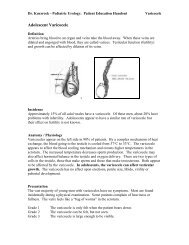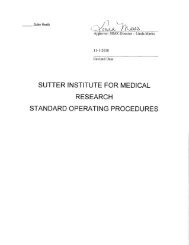Hypospadias Handout
Hypospadias Handout
Hypospadias Handout
Create successful ePaper yourself
Turn your PDF publications into a flip-book with our unique Google optimized e-Paper software.
Dr. Kurzrock - Pediatric Urology: Patient Education <strong>Handout</strong><strong>Hypospadias</strong>HYPOSPADIASWhat is hypospadias?<strong>Hypospadias</strong> is a congenital abnormality of the penis that is characterized by an abnormalposition of the urethral opening. <strong>Hypospadias</strong> appears in many forms. The urethral opening canbe anywhere from the tip of the penis to the scrotum and sometimes as far back as the anus. Themajority of cases occur with the opening near the head of the penis.<strong>Hypospadias</strong> is associated with:• Abnormal appearance of the glans penis (the head of the penis)• Abnormal foreskin formation• Downward bending of the penisHow common is hypospadias?The rate of hypospadias appears to be increasing. In the United States, it is reported to bebetween 1 per 250 to 500 male births. There is a familial tendency with increased rates whenfathers or brothers have a history of hypospadias.What causes hypospadias?In the vast majority of cases, the cause of hypospadias is unknown. Occasionally it is due toabnormal hormone action. Even more rare is an abnormality of the sexual chromosomes.Does hypospadias need to be fixed?Mild hypospadias is generally a cosmetic problem. Children with moderate or severehypospadias may have functional problems. Boys may have difficulty with urination and beunable to urinate standing up. Children with moderate or severe hypospadias also may havesome functional impairment with fertility. If your child also has curvature of the penis, this mayaffect his sexual function when he is older.
Dr. Kurzrock - Pediatric Urology: Patient Education <strong>Handout</strong><strong>Hypospadias</strong>Children will not outgrow hypospadias and there are no medicines to fix it. <strong>Hypospadias</strong> hasbeen repaired surgically for many years with high success. As in most surgery, especially forsmall children, hypospadias should be repaired by a specialist who does many repairs.How is hypospadias repaired?To bring the urethral opening to the head of the penis, a new urethral tube is created. This tube ismade from local skin and/or foreskin. If your son is suspected to have bending of the penis, anartificial erection will be induced during surgery to determine if correction is necessary. Manyabsorbable sutures are used. These will dissolve and do not need to be removed.After making a new urethral tube, quite often the surgeon will leave a drippy stent (catheter) inthe penis. This acts as a mold or cast while the new tube heals. This drippy stent will drain thebladder so your son will not need to urinate. The drippy stent is usually removed five to ten daysafter surgery in the office.What else do I need to know about the surgery?Depending on the severity of the hypospadias, surgery is usually 1-3 hours in duration. Theanesthesiologist will discuss anesthetic options. All children require general anesthesia forsurgery. In addition we prefer to use a “caudal” anesthetic. This is similar to an epiduralanesthetic, but no tubes are left in place. This will give your child up to 12 hours of regionalpain control during and after the surgery. The risks of anesthesia are extremely small and will beexplained to you by the anesthesiologist.Most hypospadias repairs are done on an outpatient basis and rarely require hospitalization.Your child will spend one to two hours in the recovery room and then will be discharged home.Some families find it more convenient to spend the first night in a local hotel. In most cases, wedo not recommend that a child return to preschool or out-of-home child-care for at least a weekafter surgery. This may require that a parent or guardian take off work for one week.What are the possible complications of the surgery?The most common complication from hypospadias surgery is the occurrence of a “fistula”. Afistula is an opening (hole) between the new urethral tube and the skin. The reported rate offistula formation is 5-20%. The risk of a fistula forming depends upon the severity of your son’shypospadias and whether he has undergone previous surgery. If your child develops a fistulaafter surgery, in most cases it is repaired in a second operation as an outpatient procedure.Other complications of hypospadias surgery include complete disruption of the repair, hematoma(large blood clot) formation, proximal regression of the urethral opening, and urethral stricture(stenosis) formation.What will my son’s penis look like after surgery?Immediately after the surgery the penis will be very swollen and discolored. This will resolveover the next few weeks. The ultimate appearance of your son’s penis is dependent on theseverity of hypospadias, whether he has had previous surgery, and the shape and size of his penisprior to surgery. Of note, your child’s penis will also dramatically change during puberty.
















